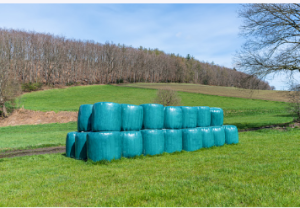Using inoculants has been an increasingly popular method of increasing the nutritional value of silages. Inoculants increase the amount of fermentation in the silos and have been found to increase animal performance.
 Unipak silage coversWhether you’re looking to feed dairy cows or hay baling for cattle, you should know the benefits of Unipak silage covers. These covers can improve digestibility and inhibit the growth of mould and yeast.
Unipak silage coversWhether you’re looking to feed dairy cows or hay baling for cattle, you should know the benefits of Unipak silage covers. These covers can improve digestibility and inhibit the growth of mould and yeast.
Fibre-digesting enzymes improve digestibility
Several researchers have studied the effects of fibre-digesting enzymes on the digestion of silage covers in hay baling. These studies have shown that using these enzymes leads to increased digestibility of silages.
In addition, the effects of fibre-digesting enzymes are attributed to the improvement of the consistency of the feed and the reduction of pathogenic microorganisms in the silage. Other benefits of these enzymes include the reduction of raw material viscosity and the speeding up of acidification.
In the past few years, these methods have helped improve the quality of silages and animal production from them. However, it is important to note that silage quality primarily depends on the raw material’s nutritional value and voluntary intake.
Enzymes have also been found to have positive effects on animal feed. They are added at all growth stages and effectively improve the digestibility of the raw material. They reduce the secretions of pathogenic microorganisms and maintain intestinal health. They have also been shown to reduce the extent of mould growth in silos.
Fibrolytic enzymes are found in the Trichoderma reesei strain of bacteria and be effective in increasing the digestibility of dry matter. They also contribute to the production of a sweeter product. However, they do not work as well in livestock that specialises in meat production.
These enzymes are added as multienzyme preparations and separately. The stability of these enzymes is important for their catalytic activity. It is also important to note that their activity is influenced by ionic strength and temperature. In addition, there are also potential side effects of the enzymes.
Wilting of the herbage before ensiling has also been shown to affect the fermentation of the silage. Wilting favours lactic acid bacteria and reduces the chances of the less-useful microbial pathways dominating the ensilage process.
Propionic acid inhibits yeast and mould growth
Whether you are storing a bale of silage or an uncut field forage, you want to ensure the cover remains intact. It is important to keep the cover airtight so the moisture can be preserved and rain does not enter the silage mass. It also helps to maintain the integrity of the plastic used for the cover.
Silages can be spoiled by mould and yeast. These organisms require the substrate and spores to grow. Moulds can also produce mycotoxins, which can be harmful to livestock. A good silage inoculant is important to reduce the risk of silage mould. Some species of clostridia can ferment sugars and amino acids into lactic acid or acetic acid. Clostridia usually live in manure and soil.
Silage contains many volatile fatty acids, which provide animal energy. When the silage is exposed to air, these acids can spoil. Moulds tend to prefer temperatures above 23degF. It is also why you should store silage in airtight bags.
When storing silage in a conventional upright silo, you should use weighted plastic covers until the silo is open for feeding. You also want to seal any holes in the bale as soon as possible.
The moisture content of the bale is also an important consideration. The higher the moisture content, the greater the risk of spoilage. You should avoid storage in a silo with a moisture content below 65 percent, which could encourage the seepage of water-soluble nutrients into the silage. It also could increase the risk of spoilage from yeasts.
To minimise the risk of mould and yeast, you should use an inoculant that contains rapid-growing lactic acid-producing bacteria. These organisms can help speed up the fermentation process.
These bacteria can also help improve the aerobic stability of silage. They produce acetic acid, mannitol, and carbon dioxide. These bacteria can also increase milk production.
The best silage inoculant will balance lactic acid and acetic acid production. If you use a liquid inoculant, you should mix the products within 24 hours. Liquid products should not be stored in direct sunlight or the same bin as water.
Forage quality and crop maturity affect the quality of bales. Plant sugar content and microbial inoculants can also play a role. A dry inoculant should be applied at a concentration of 70 percent moisture.
Comments are closed, but trackbacks and pingbacks are open.